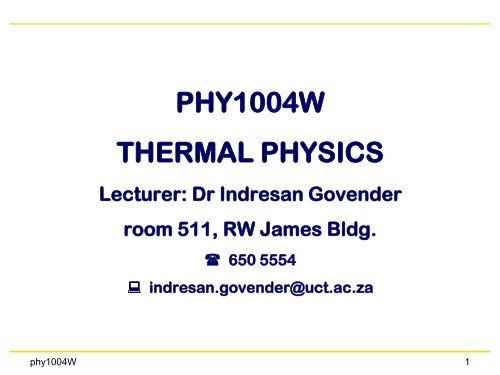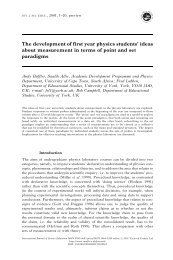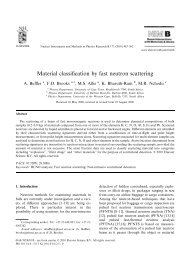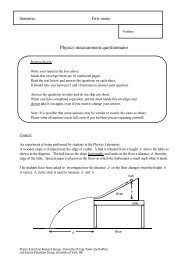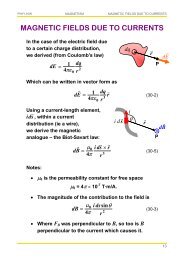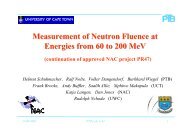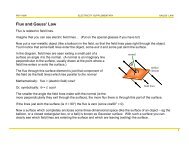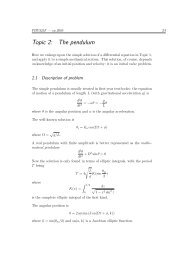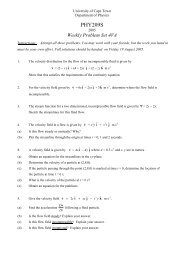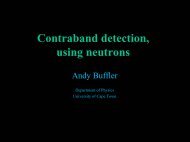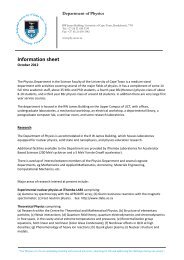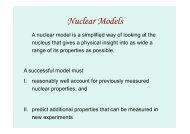phy1004 thermal physics
phy1004 thermal physics
phy1004 thermal physics
Create successful ePaper yourself
Turn your PDF publications into a flip-book with our unique Google optimized e-Paper software.
PHY1004W<br />
THERMAL PHYSICS<br />
Lecturer: Dr Indresan Govender<br />
room 511, RW James Bldg.<br />
650 5554<br />
indresan.govender@uct.ac.za<br />
<strong>phy1004</strong>W 1
<strong>phy1004</strong>W<br />
Thermal Physics<br />
Thermal Physics: Textbooks<br />
IG-10<br />
Young & Freedman: University Physics<br />
Halliday & Resnick: Fundamentals of Physics<br />
Chabay & Sherwood: Matter and Interactions<br />
Schroeder: Intro to Thermal Physics<br />
Guenault: Statistical Physics<br />
2
<strong>phy1004</strong>W<br />
Thermal Physics<br />
IG-10<br />
Thermal Physics: Websites, notes, . . .<br />
Various . . .<br />
See UCT PHY1004W <strong>thermal</strong> <strong>physics</strong> website<br />
Google !<br />
3
<strong>phy1004</strong>W<br />
Thermal Physics<br />
Einstein and thermodynamics<br />
IG-10<br />
“A theory is the more impressive the greater the<br />
simplicity of its premises, the more different kinds<br />
of things it relates, and the more extended its area<br />
of applicability. Therefore the deep impression that<br />
classical thermodynamics made upon me. It is the<br />
only physical theory of universal content which I am<br />
convinced will never be overthrown, within the<br />
framework of applicability of its basic concepts.”<br />
– A. Einstein<br />
4
<strong>phy1004</strong>W<br />
Thermal Physics<br />
IG-10<br />
Thermal Physics<br />
Thermodynamics<br />
Statistical Physics<br />
5
<strong>phy1004</strong>W<br />
Thermal Physics<br />
Thermal Physics<br />
IG-10<br />
Thermodynamics:<br />
Framework for relating macroscopic properties of a system to one<br />
another, egs.<br />
1. How does pressure of a gas depend on the temperature & volume<br />
of its container?<br />
2. How does a refrigerator work? What is its maximum efficiency?<br />
3. How much energy do we need to add to a kettle of water to<br />
change it to steam?<br />
Applications: <strong>thermal</strong> engines, egs.<br />
1. Internal combustion engine<br />
2. Steam engine<br />
6
<strong>phy1004</strong>W<br />
Thermal Physics<br />
Thermal Physics<br />
IG-10<br />
Statistical Mechanics:<br />
The goal of statistical mechanics is to begin with the microscopic<br />
laws of <strong>physics</strong> that govern the behaviour of the constituents of<br />
the system and deduce the properties of the system as a whole,<br />
egs.<br />
1. Why are the properties of water different from those of steam,<br />
even though water and steam consist of the same type of<br />
molecules?<br />
2. How are the molecules arranged in a liquid?<br />
Statistical mechanics is the bridge between the microscopic and<br />
macroscopic worlds.<br />
7
<strong>phy1004</strong>W<br />
Thermal Physics<br />
IG-10<br />
Chabay & Sherwood:<br />
Matter and interactions<br />
Ch 11:Entropy<br />
Ch 12:Gases and Engines<br />
8
<strong>phy1004</strong>W<br />
Thermal Physics<br />
CS Chapter 11 Entropy: sections<br />
IG-10<br />
11.1 Statistical issues<br />
11.2 A statistical model of solids<br />
11.3 Thermal equilibrium of two blocks in contact<br />
11.4 The second law of thermodynamics<br />
11.5 What is temperature?<br />
11.6 Heat capacity of a solid<br />
11.7 The Boltzmann distribution<br />
11.8 The Boltzmann distribution in a gas<br />
11.9 Summary: Fundamental physical principles<br />
9
<strong>phy1004</strong>W<br />
Q11.1.a<br />
Thermal Physics<br />
IG-10<br />
You put an ice cube into a styrofoam<br />
cup containing hot coffee. You would<br />
probably be surprised if the ice cube got<br />
colder and the coffee got hotter.<br />
Would this be a violation of the energy<br />
principle?<br />
1) Yes<br />
2) No<br />
3) The energy principle does not<br />
apply in this situation<br />
∆E sys = W ext + Q<br />
Q: energy flowing from surroundings into the system<br />
W ext : work done by surroundings on our system<br />
But W ext = Q = 0 … system (coffee & ice cube) is isolated<br />
Therefore: ∆E sys = 0 implies ∆E coffee + ∆E ice = 0<br />
NB: no constraint on direction w.r.t. change in energy<br />
10
<strong>phy1004</strong>W<br />
Q11.1.b<br />
Thermal Physics<br />
IG-10<br />
Consider a ball bouncing on the floor.<br />
If we consider the closed system to be the ball and floor, what is the<br />
(fundamental) cause of the ball eventually coming to rest?<br />
11
<strong>phy1004</strong>W<br />
Thermal Physics<br />
IG-10<br />
Q11.1.c<br />
Consider a ball bouncing on the floor.<br />
If we consider the closed system to be<br />
the ball and floor, which of the following<br />
principles are violated at a fundamental<br />
level?<br />
1) Momentum conservation<br />
2) Energy conservation<br />
4) None of the above<br />
12
<strong>phy1004</strong>W<br />
Thermal Physics<br />
IG-10<br />
Can the ball increase in height with each bounce?<br />
Yes<br />
No<br />
Maybe<br />
13
<strong>phy1004</strong>W<br />
Thermal Physics<br />
Bouncing Ball<br />
IG-10<br />
•Initially (before 1 st bounce) energy associated with<br />
centre of mass of ball, i.e. one degree of freedom<br />
•After several bounces energy associated with<br />
individual molecules of floor and ball, i.e. many<br />
degrees of freedom (Ball and floor feel warm!)<br />
14
<strong>phy1004</strong>W<br />
Thermal Physics<br />
Bouncing Ball<br />
IG-10<br />
1. How do we quantify these “degrees of freedom”?<br />
2. What is the relationship between<br />
a) the “degrees of freedom” available to the system,<br />
b) the “degrees of freedom” taken up by the energy,<br />
c) the likelihood of the ball increasing in height with each<br />
bounce?<br />
3. How does the likelihood of the ball decreasing in<br />
height with each bounce compare with 2(c)?<br />
4. Are we learning yet another esoteric concept?%!<br />
15
<strong>phy1004</strong>W<br />
Thermal Physics<br />
Concepts needed to begin<br />
IG-10<br />
•energy (kinetic and potential)<br />
•Temperature<br />
•Work<br />
•heat ( = <strong>thermal</strong> transfer of energy)<br />
•microscopic vs macroscopic<br />
•Reversibility<br />
•Probability<br />
16
<strong>phy1004</strong>W<br />
Thermal Physics<br />
Statistical issues<br />
IG-10<br />
•Very notion of temperature: average kinetic energy of<br />
Molecules<br />
•Large numbers of molecules: N A = 6.023 × 10 23 mole -1<br />
•Thermal energy flow: hotter to colder (on average)<br />
•Reversibility<br />
17
<strong>phy1004</strong>W<br />
Thermal Physics<br />
Reversible processes<br />
IG-10<br />
Many processes in <strong>physics</strong> are reversible, eg<br />
atomic collisions, or frictionless 2-d elastic collisions<br />
• Cannot tell forward movie from backward<br />
• Collisions possible in both directions<br />
• Laws of <strong>physics</strong> (strong, electromagnetic,<br />
gravitational interactions) completely reversible<br />
18
<strong>phy1004</strong>W<br />
Thermal Physics<br />
IG-10<br />
Observe: energy flows from hot to cold<br />
Spontaneous<br />
19
<strong>phy1004</strong>W<br />
Thermal Physics<br />
IG-10<br />
Ever observe energy flow from cold to hot??<br />
Not spontaneous<br />
20
<strong>phy1004</strong>W<br />
Thermal Physics<br />
Irreversible processes<br />
IG-10<br />
•No <strong>physics</strong> principle makes reverse<br />
process impossible<br />
• Chance of reverse process occurring<br />
may be VERY small<br />
• This process is called irreversible<br />
21
<strong>phy1004</strong>W<br />
Thermal Physics<br />
Apparent Paradox in Thermodynamics<br />
•All fundamental processes exhibit time reversal invariance,<br />
i.e. Both forward and backward movie of fundamental<br />
interactions look possible (have seen them before!!!)<br />
•Macroscopic change has a preferred direction, egs.<br />
►Bouncing balls come to rest … & never reverse their motion<br />
►Energy moves from hot to cold … & never the reverse direction<br />
•If the sub-microscopic world exhibits time reversal invariance,<br />
surely the macroscopic world (which is made up of the submicroscopic)<br />
should also be time reversal invariant !<br />
IG-10<br />
•Better to think of macroscopic change statistically<br />
►Bouncing ball increasing in height with each bounce is<br />
NOT impossible, just wildly (ridiculously!!) improbable<br />
22
<strong>phy1004</strong>W<br />
Thermal Physics<br />
IG-10<br />
Practical Example on Probability<br />
Consider the following collection of balls in a box:<br />
5000 red<br />
100 green<br />
3 blue<br />
4 yellow<br />
1. If you reached into the bag (without looking !!),<br />
which colour ball are you most likely to pick up?<br />
2. Can you estimate the likelihood of picking up a:<br />
a) Yellow ball?<br />
b) Green ball?<br />
c) Blue ball?<br />
d) Red ball?<br />
23
<strong>phy1004</strong>W<br />
Thermal Physics<br />
Modelling strategy<br />
•Use a simple (we’ll use simplest) model of a solid to<br />
understand the distribution of energy between the atoms<br />
IG-10<br />
•Determine probability of particular energy (speed)<br />
distributions<br />
•Use this probability to understand why certain<br />
distributions are VERY unlikely and others a sure bet<br />
•Test microscopic predictions with macroscopic<br />
measurements<br />
24
<strong>phy1004</strong>W<br />
Thermal Physics<br />
Modelling strategy<br />
•Use a simple (we’ll use simplest) model of a solid to<br />
understand the distribution of energy between the atoms<br />
IG-10<br />
•Determine probability of particular energy (speed)<br />
distributions<br />
•Use this probability to understand why certain<br />
distributions are VERY unlikely and others a sure bet<br />
•Test microscopic predictions with macroscopic<br />
measurements<br />
25
<strong>phy1004</strong>W<br />
Thermal Physics<br />
Model of solid: massive ball and springs<br />
IG-10<br />
We will use model to ask detailed quantitative questions<br />
about energy distribution in solid<br />
26
<strong>phy1004</strong>W<br />
Thermal Physics<br />
IG-10<br />
Simplified model: Einstein (1907) model of a solid<br />
Assumptions:<br />
•Each atom in the lattice is a 3D quantum mechanical oscillator (based on<br />
Planck’s quantisation assumption)<br />
•Each atom moves independently (connected to imaginary rigid walls; not<br />
other atoms) No mechanism for energy exchange between atoms<br />
•All atoms vibrate with the same frequency<br />
•Ignore collective motion of groups of atoms<br />
<br />
0<br />
<br />
27
<strong>phy1004</strong>W<br />
Thermal Physics<br />
Atom as a 3-d oscillator<br />
IG-10<br />
x, y and z motion independent, so 3-d oscillator is<br />
equivalent to three 1-d oscillators.<br />
28
<strong>phy1004</strong>W<br />
Thermal Physics<br />
IG-10<br />
Energy of atom (as three 1-d oscillators)<br />
29
<strong>phy1004</strong>W<br />
Thermal Physics<br />
Quantized energy levels of 1-d oscillator<br />
IG-10<br />
n = 0, 1, 2, 3, etc<br />
Energy added to 1-d atomic oscillator only in multiples of:<br />
30
<strong>phy1004</strong>W<br />
Thermal Physics<br />
Quantum Mechanical Oscillator<br />
IG-10<br />
31
<strong>phy1004</strong>W<br />
Thermal Physics<br />
Three one dimensional Oscillators<br />
IG-10<br />
32
<strong>phy1004</strong>W<br />
Thermal Physics<br />
Distributing energy amongst objects<br />
IG-10<br />
Simple case: One atom equivalent to three oscillators.<br />
Imagine atom has 4 quanta of energy.<br />
Distribute 4 quanta over 3 oscillators.<br />
How much to each oscillator?<br />
How many ways to do it?<br />
Counting begins . . .<br />
(Finally, we shall derive a formula)<br />
33
<strong>phy1004</strong>W<br />
Thermal Physics<br />
4 quanta over 3 osc: three ways<br />
IG-10<br />
3 ways of distributing 4 quantum of vibrational energy<br />
amongst 3 one-dimensional oscillators<br />
34
<strong>phy1004</strong>W<br />
Thermal Physics<br />
4 quanta over 3 osc: six more ways<br />
IG-10<br />
6 more ways of distributing 4 quantum of vibrational<br />
energy amongst 3 one-dimensional oscillators<br />
35
<strong>phy1004</strong>W<br />
Thermal Physics<br />
IG-10<br />
4 quanta over 3 osc: yet six more ways<br />
Still more ways of distributing 4 quantum of vibrational<br />
energy amongst 3 one-dimensional oscillators<br />
36
<strong>phy1004</strong>W<br />
Thermal Physics<br />
Microstates and macrostates<br />
There are 15 microstates.<br />
IG-10<br />
Each microstate is a way to distribute the energy.<br />
All microstates belong to the same macrostate.<br />
The macrostate has 4 quanta of energy.<br />
The 4-quanta macrostate can also be categorised into types:<br />
•(4,0,0) type 400<br />
•(2,1,1) type 211<br />
•(3,1,0) type 310<br />
•(2,2,0) type 220<br />
Which type is most likely to occur?<br />
37
<strong>phy1004</strong>W<br />
Thermal Physics<br />
IG-10<br />
Q11.2.a<br />
Consider 4 quantized oscillators (a model for 1 and 1/3<br />
atoms!). They share 2 "quanta" of energy. List all the<br />
ways you can arrange these 2 quanta of energy among<br />
the 4 oscillators (such as "2000"); how many<br />
arrangements are there?<br />
1) 4<br />
2) 7<br />
3) 10<br />
4) 15<br />
5) 20<br />
2000 1100 1010<br />
0200 0110 1001<br />
0020 0011 0101<br />
0002<br />
38
<strong>phy1004</strong>W<br />
Thermal Physics<br />
FUNDAMENTAL ASSUMPTION of<br />
STATISTICAL MECHANICS<br />
IG-10<br />
An isolated system is equally likely, over time, to be<br />
found in any one of the fully-specified states<br />
accessible to it.<br />
NB: This assumption allows all possible<br />
configurations of the system (macrostate) if we<br />
observe it for long enough.<br />
However, you might have to wait a very long time to<br />
observe certain configurations<br />
39
<strong>phy1004</strong>W<br />
Thermal Physics<br />
Two blocks in <strong>thermal</strong> contact<br />
IG-10<br />
Take two simple blocks. Take two atoms! (one from<br />
each block)<br />
Count ways to distribute 4 quanta of energy between<br />
the two atoms (six oscillators)<br />
40
<strong>phy1004</strong>W<br />
Thermal Physics<br />
IG-10<br />
All 4 quanta to one atom, none to the other<br />
30 microstates.<br />
41
<strong>phy1004</strong>W<br />
Thermal Physics<br />
3 to one atom, and 1 to the other<br />
IG-10<br />
60 microstates.<br />
42
<strong>phy1004</strong>W<br />
Thermal Physics<br />
2 to one, and 2 to the other<br />
IG-10<br />
36 microstates.<br />
43
<strong>phy1004</strong>W<br />
Thermal Physics<br />
Table of all 15 + 30 + 36 + 30 + 15 = 126 ways<br />
IG-10<br />
44
<strong>phy1004</strong>W<br />
Thermal Physics<br />
Histogram of number of microstates<br />
IG-10<br />
45
<strong>phy1004</strong>W<br />
Thermal Physics<br />
IG-10<br />
One system many times, or many systems once?<br />
Make many observations of our system.<br />
In 29% of these we have a 2|2 split.<br />
OR<br />
Make many copies of our system (macrostate).<br />
Observe each one.<br />
In 29% of these we have a 2|2 split.<br />
46
<strong>phy1004</strong>W<br />
Thermal Physics<br />
IG-10<br />
Q11.2.a<br />
Two objects share a total energy E = E 1 +E 2 . There<br />
are 10 ways to arrange an amount of energy E 1 in<br />
the first object and 15 ways to arrange an amount<br />
of energy E 2 in the second object. How many<br />
different ways are there to arrange the total energy<br />
E = E 1 +E 2 so that there is E 1 in the first object and<br />
E 2 in the other?<br />
Ω(E) = Ω(E 1 ) Ω(E 2 )<br />
= (10)(15)<br />
= 150<br />
1) 10<br />
2) 15<br />
3) 25<br />
4) 150<br />
5) 1x10 15<br />
Using Greek symbol Ω “Omega” to represent # of ways<br />
47
<strong>phy1004</strong>W<br />
Thermal Physics<br />
IG-09<br />
A system of 300 oscillators contains 100 quanta of energy. What is the<br />
physical meaning of this model?<br />
1) one atom oscillating in 300 dimensions<br />
2) 300 atoms, each in the 100th energy level<br />
3) 300 atoms with 100 joules of energy distributed among them<br />
4) 100 atoms with 300 joules of energy distributed among them<br />
5) 100 atoms with 100* *sqrt(k s /m a ) joules of energy among them<br />
6) something else<br />
48
<strong>phy1004</strong>W<br />
Thermal Physics<br />
IG-09<br />
A formula for the number of microstates<br />
We shall derive a formula<br />
for the number of microstates with q quanta<br />
divided amongst N oscillators<br />
49
<strong>phy1004</strong>W<br />
Thermal Physics<br />
Sequences of removing five numbered balls<br />
from a bag<br />
IG-09<br />
How many sequences?<br />
5 × 4 × 3 × 2 × 1 = 5! = 120<br />
50
<strong>phy1004</strong>W<br />
Thermal Physics<br />
IG-09<br />
Permutations of three objects<br />
We list permutations of 3 objects:<br />
1 2 3<br />
1 3 2<br />
2 1 3<br />
2 3 1<br />
3 1 2<br />
3 2 1<br />
The number of permutations is 3 × 2 × 1 = 6 = 3!<br />
For n objects, there are n! permutations. Note 0! = 1<br />
51
<strong>phy1004</strong>W<br />
Thermal Physics<br />
Making fewer distinctions<br />
IG-09<br />
Of the five balls, imagine three are red, and two green.<br />
Say we do not care about the ball number, just the colour,<br />
eg RRRGG or RGRGR.<br />
There are 5! = 120 numbered sequences.<br />
There are 3! = 6 permutations of red balls, and<br />
there are 2! = 2 permutations of green balls.<br />
Thus the number of different colour sequences is:<br />
52
<strong>phy1004</strong>W<br />
Thermal Physics<br />
IG-09<br />
Colour sequences: three red, two green<br />
RR GG R<br />
RR GR G<br />
RR RG G<br />
RG RR G<br />
RG RG R<br />
RG GR R<br />
GR RR G<br />
GR RG R<br />
GR GR R<br />
GG RR R<br />
53
<strong>phy1004</strong>W<br />
Thermal Physics<br />
Arranging quanta amongst oscillators<br />
IG-09<br />
6 objects: 4 quanta and 3 − 1 = 2 bars.<br />
Number of arrangements = 6!/(4! 2!) = 720/(24×2) = 15<br />
54
<strong>phy1004</strong>W<br />
Thermal Physics<br />
IG-09<br />
A formula for the number of microstates<br />
number of microstates with q quanta divided<br />
amongst N oscillators<br />
gets very big very fast!<br />
For q = 100 and N = 300, Ω = . . . = 1.7 × 10 96<br />
Probability that all 100 quanta are on oscillator<br />
number 3 is<br />
P(0, 0, 100, 0, . . . , 0) = 1/ Ω ≈ 0.6 × 10 −96<br />
Not impossible, but VERY unlikely!!<br />
55
<strong>phy1004</strong>W<br />
Thermal Physics<br />
How do we use formula?<br />
IG-09<br />
Program syntax<br />
Program<br />
1 combin(a, b) Vpython<br />
2 combin(a, b) Excel<br />
3 exp(gammaln(a+1) + gammaln(b+1) +<br />
gammaln(a-b+1))<br />
Matlab/Octave<br />
a = q + N - 1<br />
b = q<br />
a-b = N - 1<br />
56
<strong>phy1004</strong>W<br />
Thermal Physics<br />
Stirling’s Theorem<br />
One form of Stirling’s theorem is that for large n<br />
IG-09<br />
If n is very large we can simplify this by taking logs<br />
Noticing that is much smaller than other terms for large n,<br />
we can simply further as<br />
57
<strong>phy1004</strong>W<br />
Thermal Physics<br />
IG-09<br />
A useful formulae for # of ways per macrostate type<br />
Given an isolated system of N oscillators and q quanta.<br />
Suppose the distribution of the quanta is such that n 1 ,<br />
n 2 , n 3 , …, n m oscillators contain quanta q 1 , q 2 , …, q m<br />
respectively. This distribution is a type of macrostate.<br />
The total number of ways of constructing this<br />
macrostate type is:<br />
58
<strong>phy1004</strong>W<br />
Q11.2.d<br />
Thermal Physics<br />
Which microstate is most probable?<br />
1) A<br />
2) B<br />
3) C<br />
4) D<br />
5) They’re equally probable<br />
IG-09<br />
NB: over time, all microstates are equally probable!<br />
59
<strong>phy1004</strong>W<br />
Q11.2.d<br />
Thermal Physics<br />
Which type of macrostate (A, B, C, D)<br />
is most probable?<br />
1) A<br />
2) B<br />
3) C<br />
4) D<br />
5) They’re equally probable<br />
IG-09<br />
NB: over time, all microstates are equally probable!<br />
The most probable type of macrostate is the one with the most # of ways to<br />
exist (A, B, C & D are microstates from particular types of macrostates of<br />
which the B-type macrostate is the most probable)<br />
60


